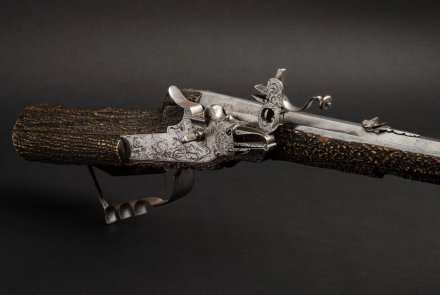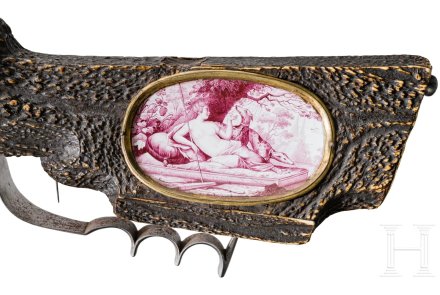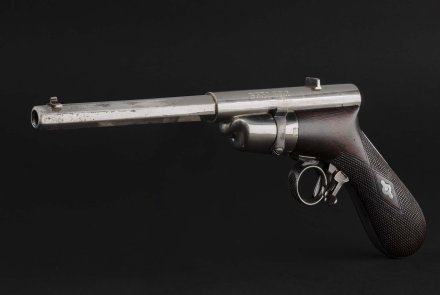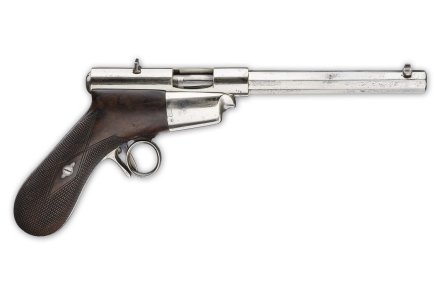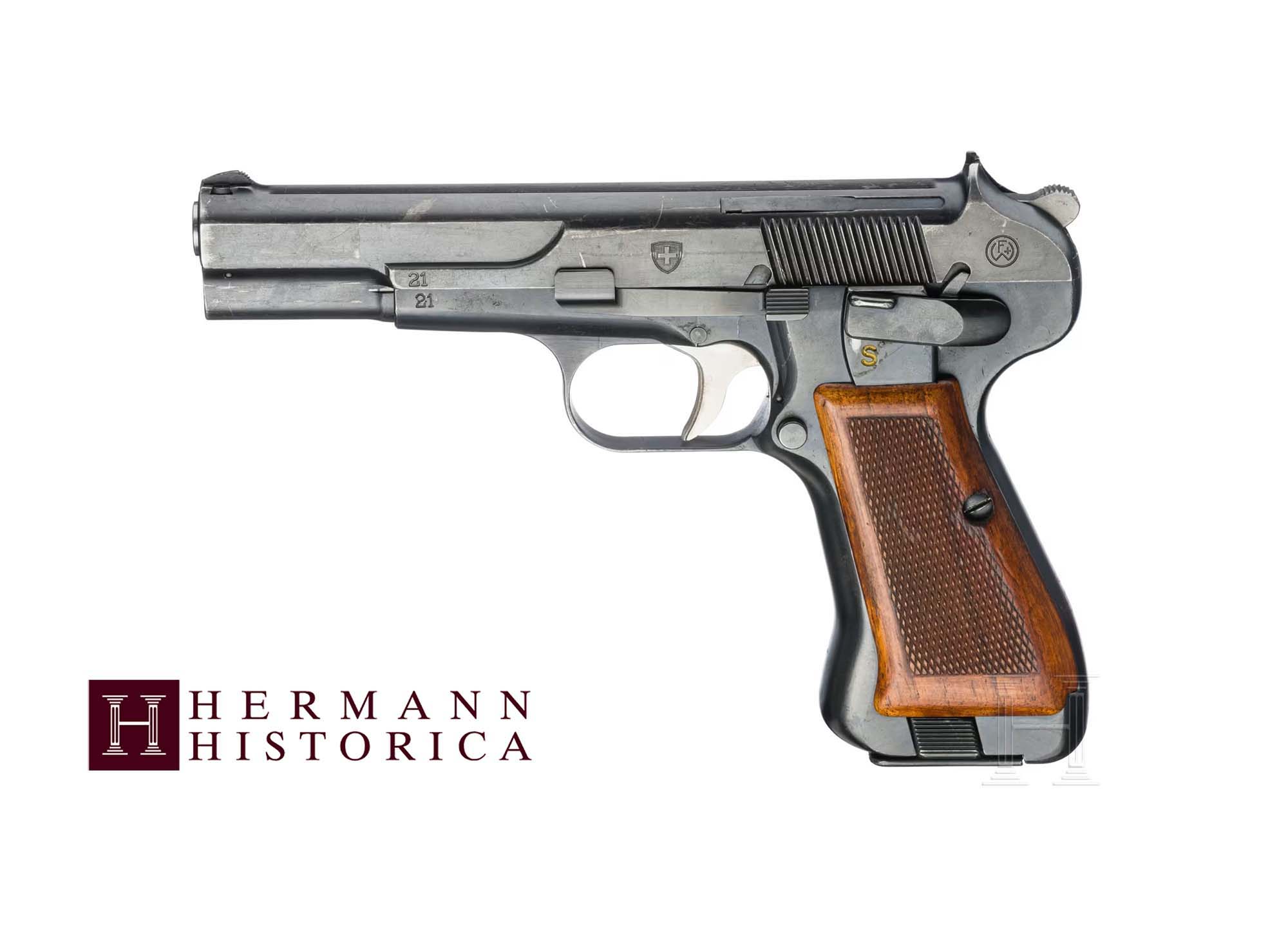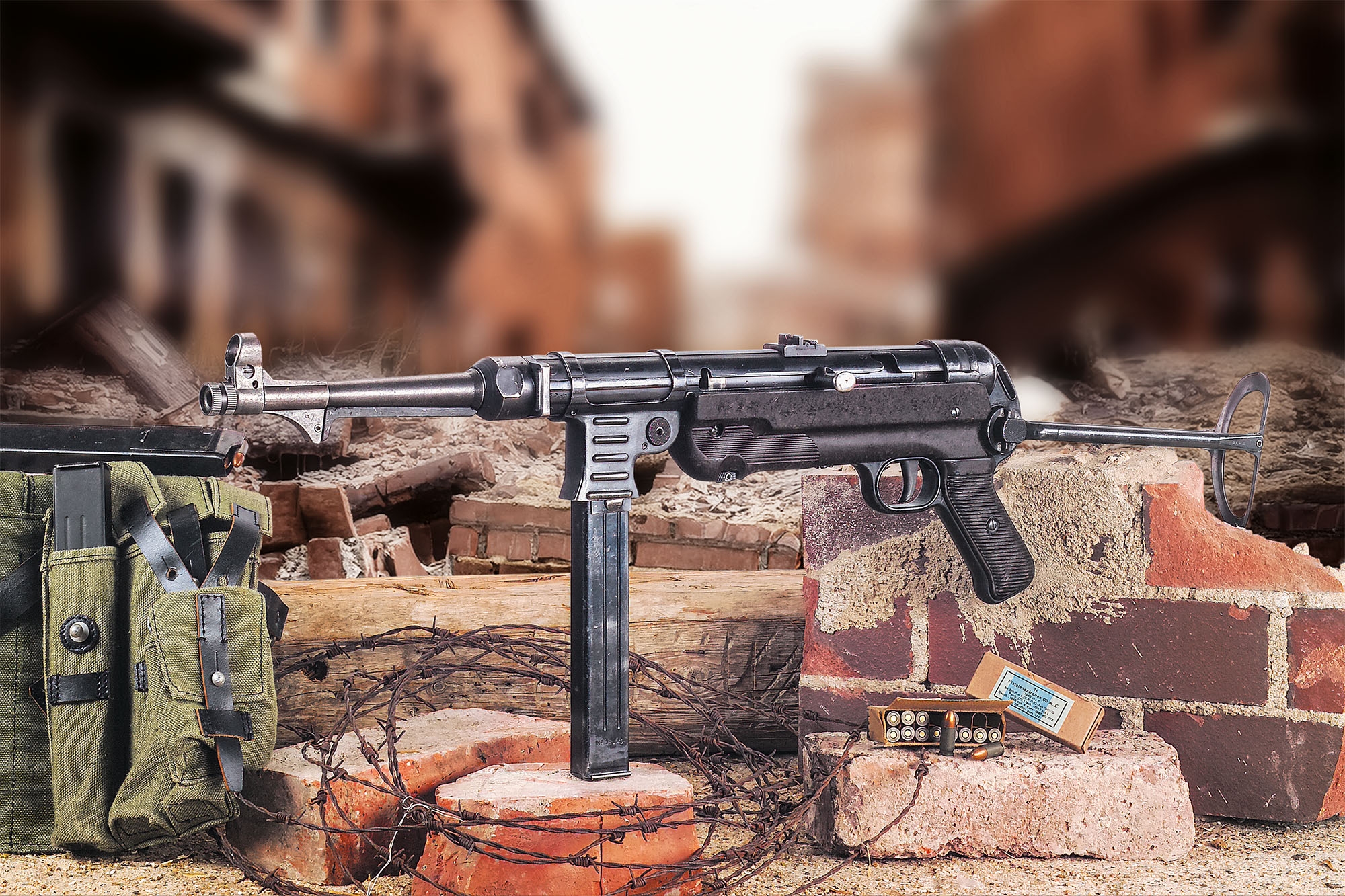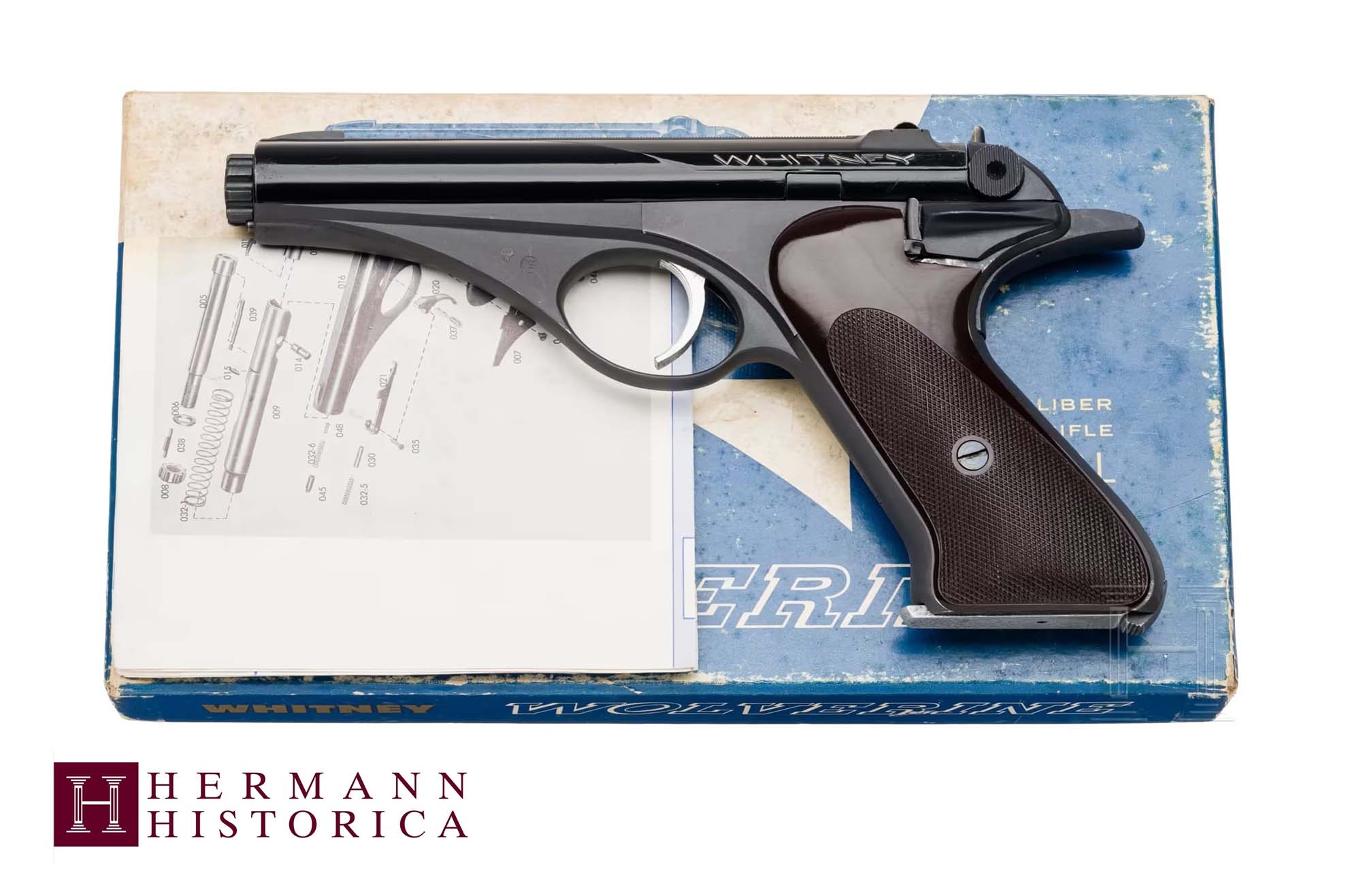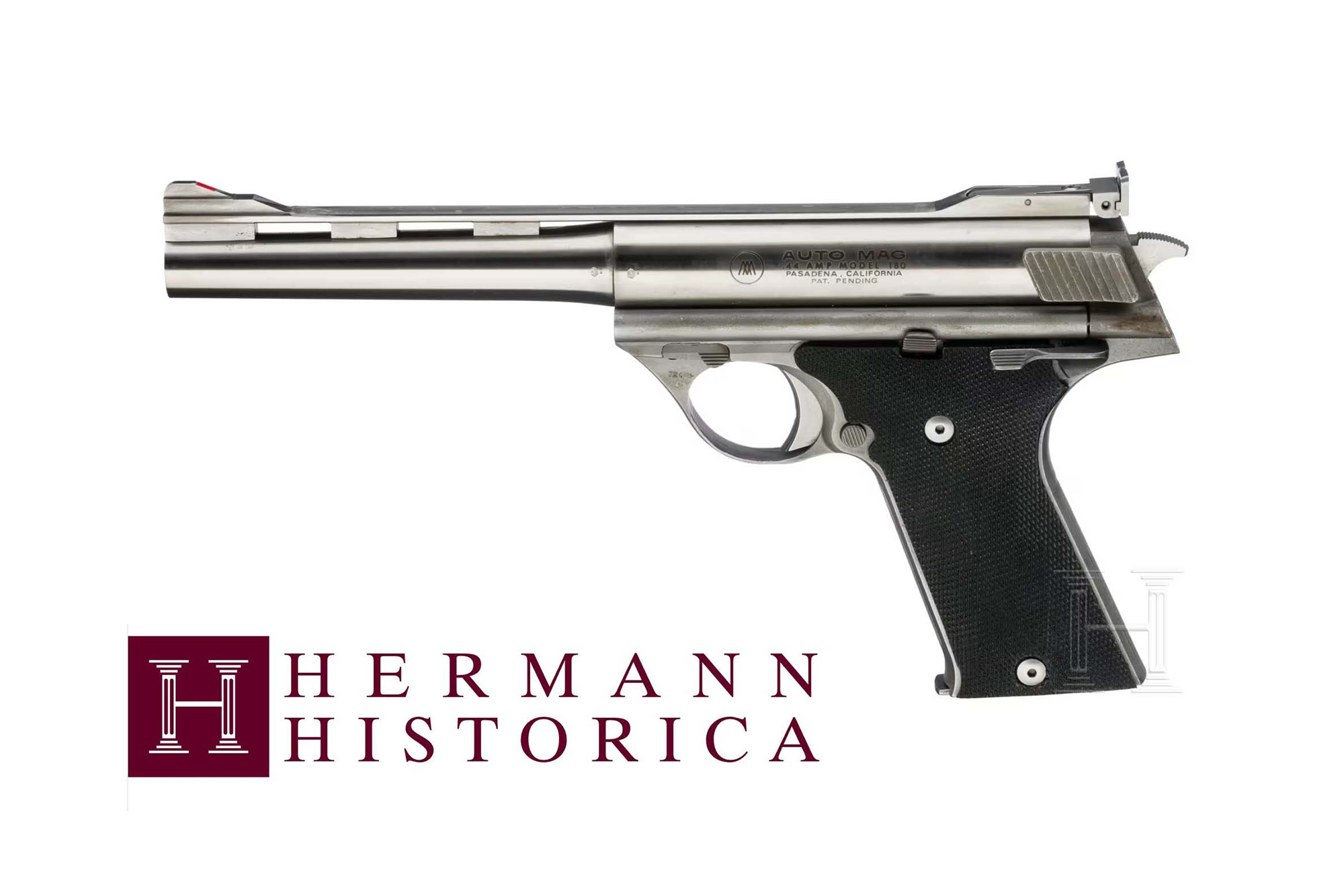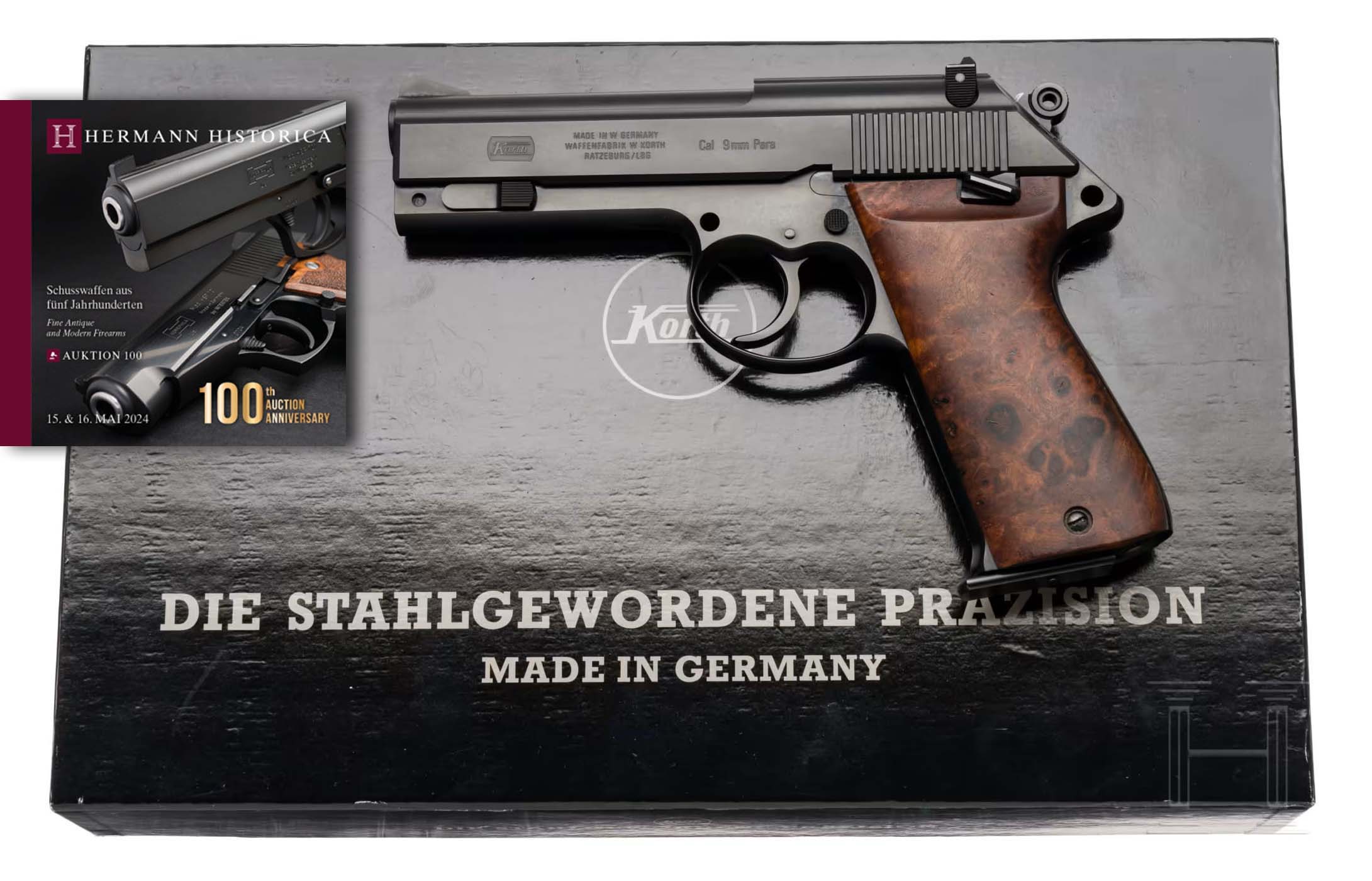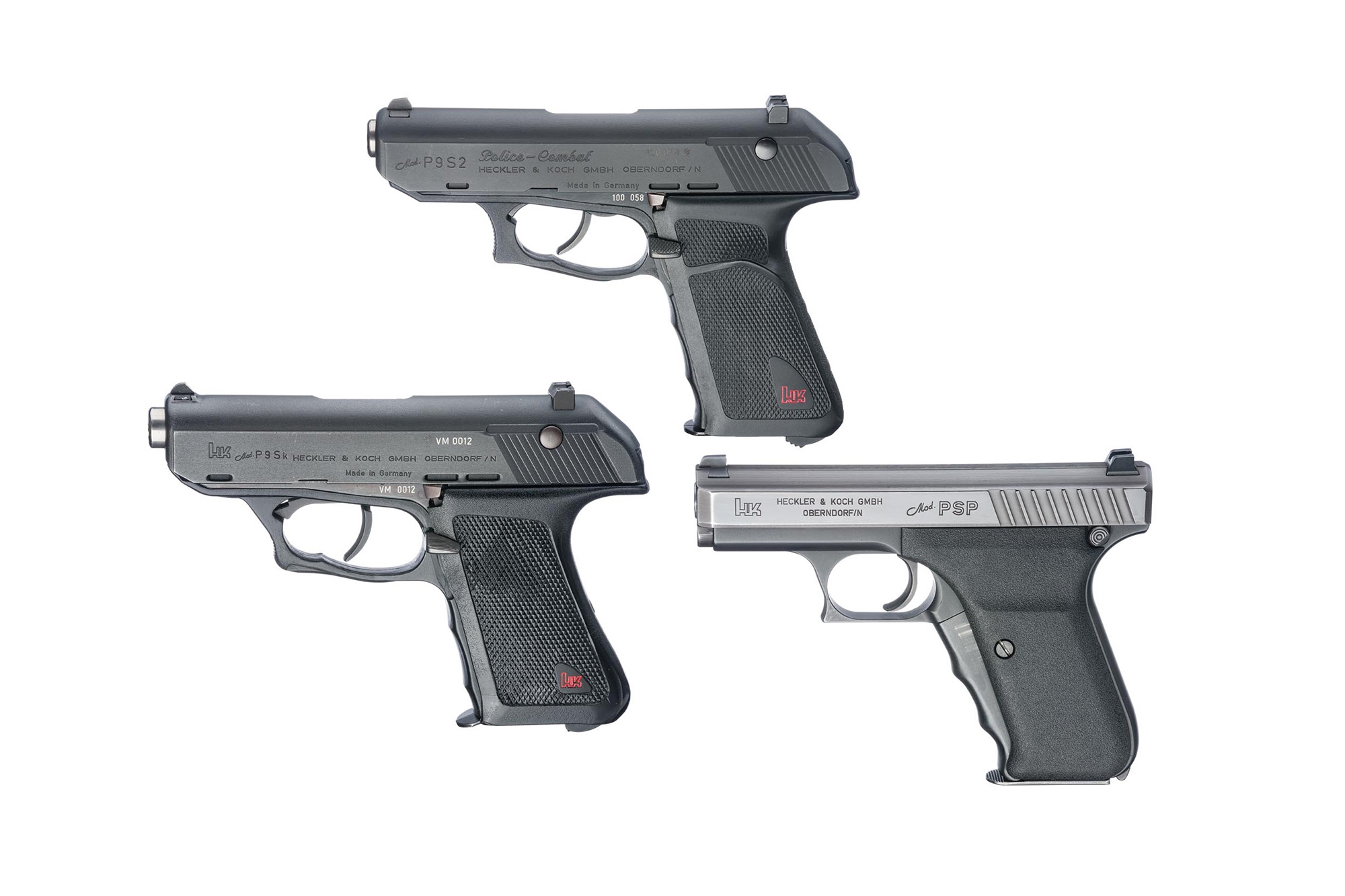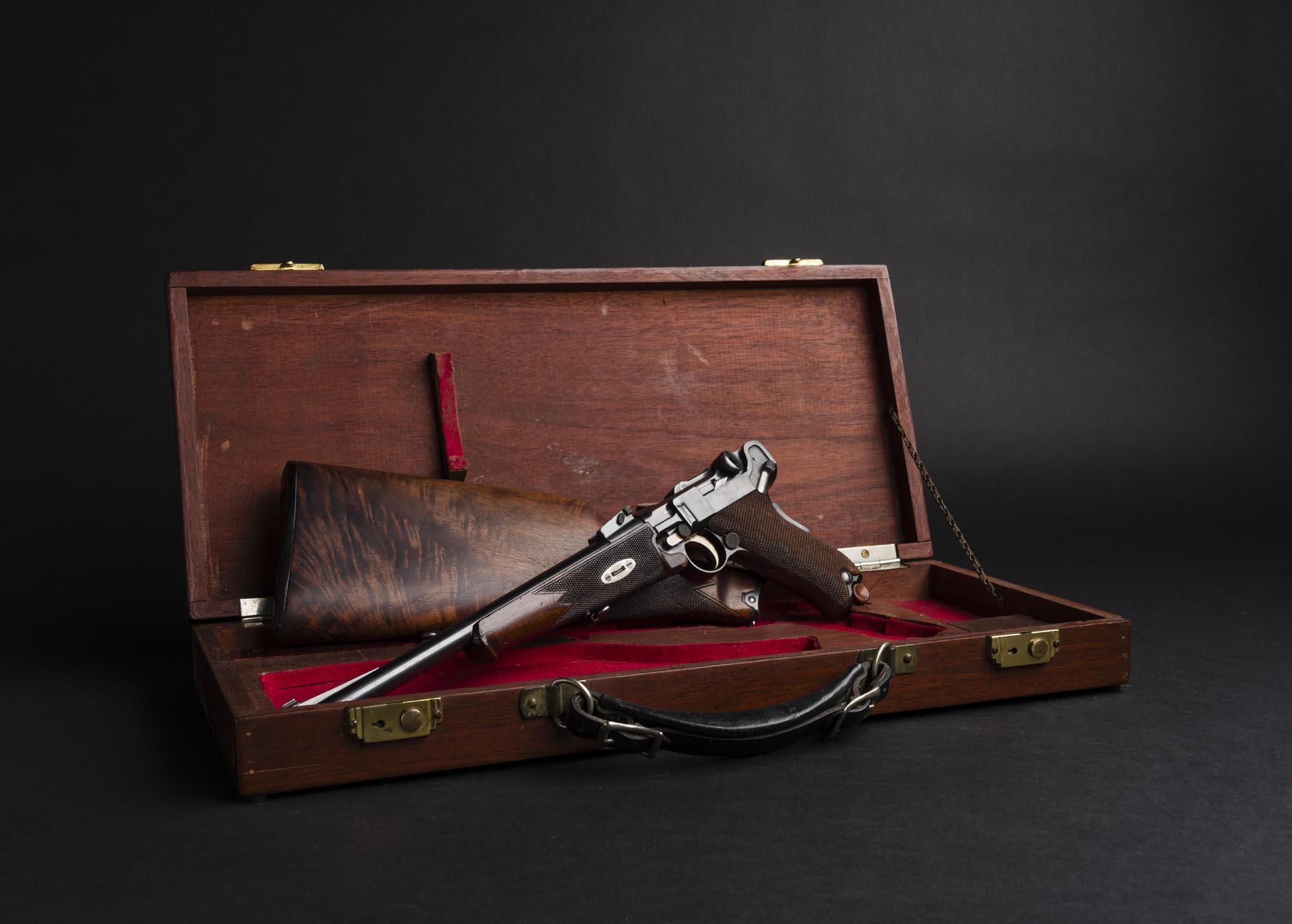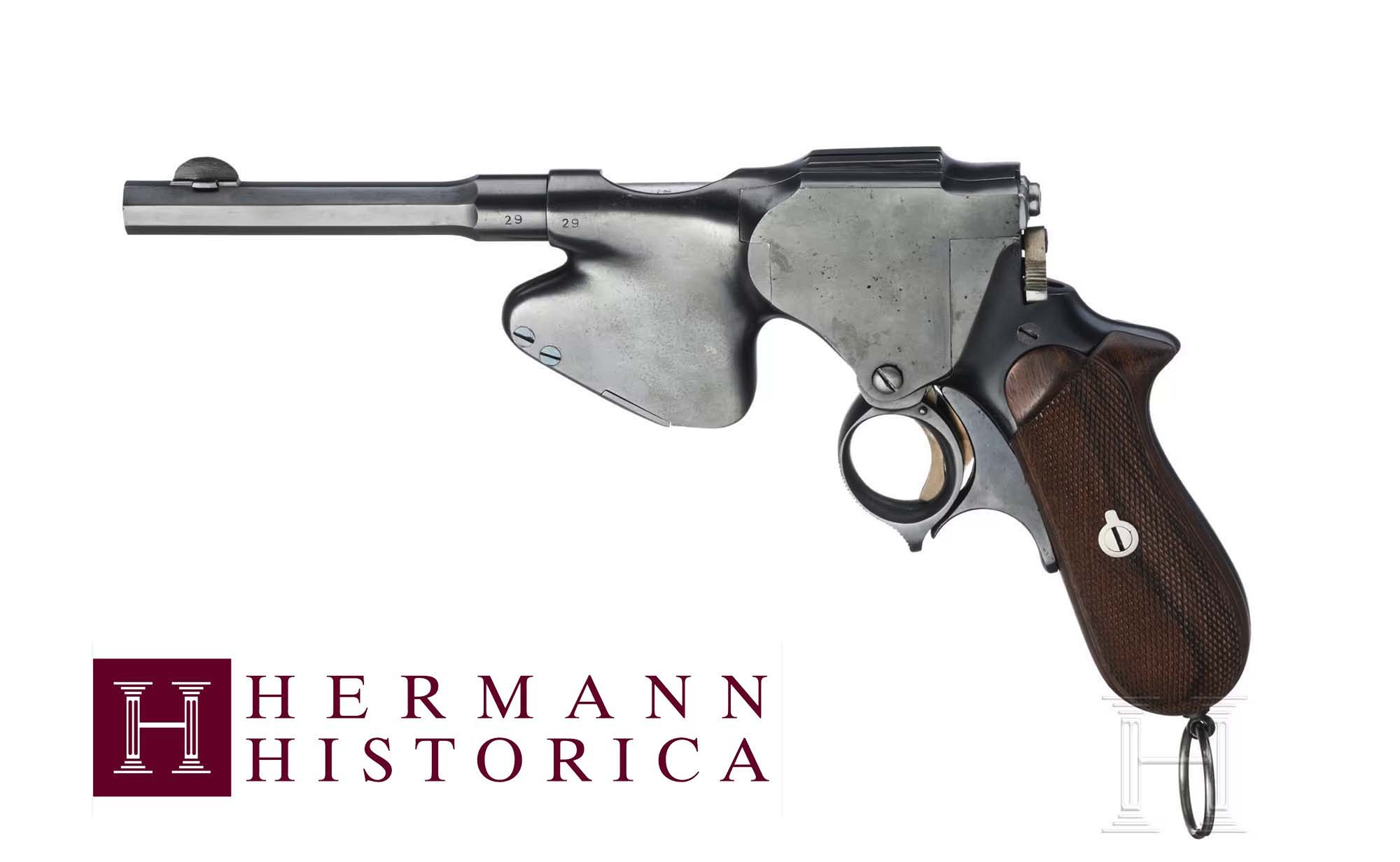Auction number 92, organized by the Bavarian auction house Hermann Historica, will be titled as usual "Five centuries of antique and modern Firearms”. But despite the fact that the title is by now familiar to us, in reality nothing can be taken for granted, starting with the titanic online catalog of no less than 636 pages, which alone represents an extraordinary collector's item and describes just under a thousand lots up for auction.
For the May 18 auction, Hermman Historica's offering also includes a number of very interesting pieces from the collection of Manfred Knothe, one of the foremost experts on modern and pre-modern pistols. Born in Germany in 1938, Knothe began his interest in guns and ammunition as a boy and is internationally known for his encyclopedic knowledge, with a particular interest in the guns manufactured by Bergmann. Now, for health reasons, Knothe is forced to say goodbye to his extraordinary collection of rare and unique pieces. But the first gun we want to tell you about is not German or Swiss: it comes from Italy and is extremely rare today, if not impossible to find in this configuration.
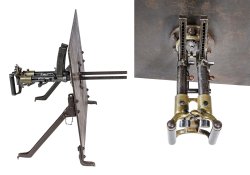
One of the most extraordinary pieces at auction is in fact lot 2698, a Villar Perosa 1915 cal. 9x19 mm Glisenti submachine gun, the first weapon of its kind to be used in war. This weapon designed by A. Revelli, featuring a delayed blowback action, was in fact composed of two machine guns that could fire independently thanks to the trigger that was operated with the thumb.
The receiver is made of bronze and is marked with the company name "Officine / Villar Perosa" in an oval, below which is the serial number "1843". Selector switch is marked "S" and "F". The two black barrel tubes are undamaged and the gun is complete with two 25 round magazines and the very rare complete shield unit, which also served as a kind of tripod, with original 60% gray paint. The machine gun rests in the shield in a spherical attachment, which not only allows for quick assembly and disassembly, but also allows the gunner to swivel the barrel vertically and horizontally.
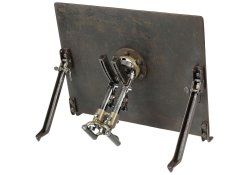
The shield consists in a solid steel plate, 8 mm thick, 70 cm wide and 55 cm high, and weighs 27.5 kg by itself. It has two foldable supports. Total weight is 33.5 kg. This is a configuration of extreme rarity, as the shield was usually discarded, its weight making it almost impossible for the gunner to move. This gun belonged to the great-grandson of an Austrian imperial soldier who, as part of a unit of the Slovenian army, participated in 1917 in the 12th battle of the Isonzo near Kobarid, where the Austrian imperial army broke through the Italian defenses. The Austrians captured this machine gun from the Italians and turned it against them. When the war ended, grandpa took the machine gun home and stowed it away, using the shield as a support for a window. When he died, his grandson inherited the gun and had it registered, which allowed the current owner to legally have it. Starting price for this extraordinary item is 23,000 euros.
Lot 2039 is an extraordinary German wheellock rifle, manufactured in Augsburg around 1660 featuring an octagonal barrel in 12.5 mm caliber. The wheellock with internal wheel features a wild boar hunting scene, the cock engraved with sea monsters. The wooden full stock, is veneered with staghorn plates, stamped “EB” on the inside. On the left side of the butt is an enameled copper plaque with a depiction of Diana resting with her hunting dogs in a gilt brass frame. The stock has a smooth iron trigger guard. The ramrod thimbles and buttplate are also staghorn. It is very likely that this weapon came from the armory of the Grand Dukes of Saxe-Weimar in the Ettersburg Castle, as suggested by the presence of the initials "EB" on the patch box. Weapons from the Ettersburg Castle armory were offered for purchase on several occasions in the late 19th century, with sales continuing until after World War I. The 1927 auction held by Fischer/Kahlert included among the lots for sale a wheellock rifle that was entirely veneered in staghorn, like the one presented here, and featured an enamel medallion on the butt. This gun is nearly identical to the one today in the collection of the Metropolitan Museum of Art in New York (Accession Number: 2015.446a-d), signed by Martin Kammerer, active in Augsburg. Wheellock firearms completely covered in rough staghorn with a largely natural finish were very much in vogue in Germany in the decades between the mid-17th and early 18th centuries. The few examples still surviving to this day suggest that Augsburg was the production center for these guns. A similar rifle is currently part of the collection of the Bayerisches Nationalmuseum in Munich (inventory number: W994). The starting price is €45,000.
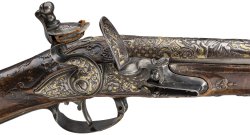
At lot 2060 we find an interesting flintlock gun made in South Germany, circa 1730/40. The round barrel is smoothbore, in 14 mm caliber. At the breech and around the silver front sight we find chiseled decorations on a golden background, depicting the goddess of the hunt Diana standing between mascarons and scrolling foliage. The lock is richly engraved with depictions of animals and mascarons. Full walnut stock with finely carved tendrils and rocailles. The stock has a crack near the lock and shows minor flaws and repairs, while the original end of the forestock has been replaced. Furniture is high quality chiseled iron with gold inlays and hunting motifs. The side plate is pierced, with the depiction of three hounds, while on the trigger guard we find the figure of a lying stag. The butt cap shows hounds fighting a stag. The ramrod with horn tip has been replaced. Length 135 cm. The starting price for this princely and expertly restored shotgun is €11,000.
Lot 2072 is a deluxe double-barrelled flintlock shotgun with box lock, made by Gauvain à Angres (France) dated 1800. The barrels are two stage, octagonal towards the breech, then round, in 14.5 mm caliber with original bluing; the barrel root, the muzzle and midrib are finished with heavy fire gilding. At the breech we find the finely engraved signature "Gauvain Pere & Fils, Inv & Fec. - Arquebusiers à Angers, An. 1800" The barrel maker's mark "E. Durand Tordu" is struck on the underside. The dolphin-shaped hammers are delicately chiseled. The hand rest of the stock is finely checkered and set with diamond studded iron nails, while on both sides the cheek rest is decorated with gilt bronze appliqués in the shape of dolphins. The butt is decorated on both sides with fine silver inlays amidst curled silver shavings. Depiction of hunters shooting at a variety of game. The iron butt cap is lightly chiseled. The overall length of the gun is 123.5 cm. The starting price for this interesting collector's piece is €16,500.
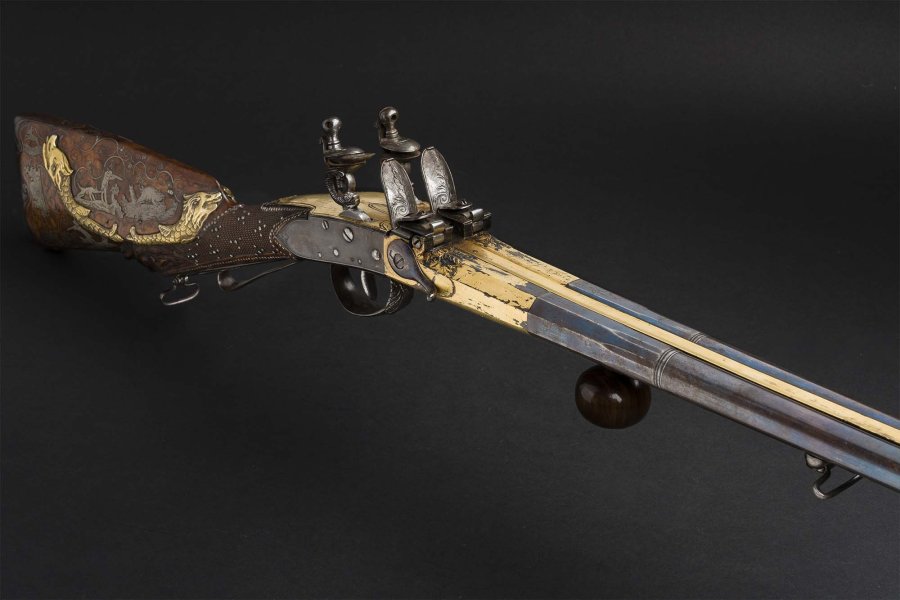
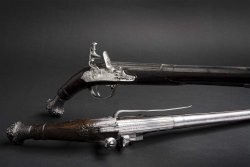
At lot 2082 we find a pair with flintlock pistols from Cunet, Lyon, built around 1660. The double stepped, Italian export barrels, are smooth bore and feature reinforced muzzles, struck with the inscription "Lazari Cominaz". The flintlock are exquisitely engraved with a standing female figure holding a banner signed "Cunet à Lion". Engravings also stretch across the hammers, frizzens and springs. On the side opposite the lock two iron suspension bars. The engraved iron pommels tapering into fully sculptured, chiselled mascarons. The ramrods are original, made of wood with horn tips. The length of the guns is 47.5 cm. Claude Cunet is known to have been an active gunsmith in Lyon in 1651. The starting price of this pair of interesting flintlock pistols is €12,000.
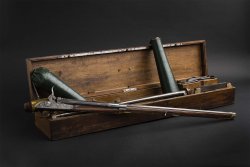
Lot 2127 is an extraordinary example of a Gilardoni system air rifle of South German/Austrian production, complete with carrying case and accessories, made around 1800. The rifle features an octagonal barrel in 11.5mm caliber, dovetailed brass front sight and a very elaborately cut rear leaf sight. In the muzzle area and above the chamber silver inlays and "AF" monogram. Lateral tubular magazine, cover lid spring missing. Central piece and lock side plate in brass with fine engravings. Lock and cock with fine floral engravings, blued screws, on the side opposite the lock is the setting screw for the amount of air pushing the bullet. Forestock with brass furniture, wooden ramrod with brass tip.
The Gilardoni system rifle (or Girardoni, from the name of its inventor) at the time called "schioppo a vento" is accompanied by two additional iron reservoirs with somewhat worn green leather covers. Length without reservoir 84.5 cm, length of each reservoir 32 cm. Comes in its original lockable wooden case (worn-eaten in places) with many original accessories such as air pump, footrest, valve key, bullet mold and three ring keys. For its completeness and its state of preservation it is to be considered an extraordinarily rare collector's item and the starting price of €12,000 is absolutely justified.
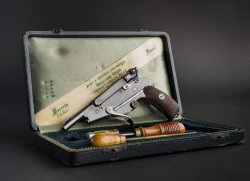
Let's now move into the fascinating world of pre-modern pistols, with lot 2262, a Bergmann mod. 1896 no. 2 pistol, with folding trigger, in its case. This semiautomatic pistol, which was designed by Louis Schmeisser, carrying serial number 6 is chambered in 5 mm Bergmann M96 caliber, and features an octagonal barrel, 90mm long. The characteristic of this model is the folding trigger, typical of the first models (about up to serial number 400), after which a fixed trigger was adopted. On the left side of the receiver we find the inscription "Patent / Bréveté / S.G.D.G." while on the right side the company logo, a dwarf miner in an oval and the inscription "Gaggenau - V.C.S. Suhl".
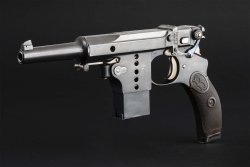
The pistol has no magazine and shows some signs of wear. The grips are walnut, checkered, and have matching serial numbers. The pistol is accompanied by an original case covered in black sheep leather, with the lid lined with green silk. The floor is velvet lined and contains the original accessories: an oil bottle, a cleaning brush, and a screwdriver. The starting price for this gun of high collector's value is very interesting: 1500 euros.
Another interesting lot (2417) is the Bergmann 1897 number 5 pistol in caliber 7.8 mm Bergmann with serial number 402 that has a unique sliding rear sight scaled (a bit optimistically) from 100 to 1000 meters. The backstrap features a slot for a shoulder stock/holster. On the barrel there is the inscription: PISTOLET BERGMANN/PATENT BREVETÉ S.G.D.G. The starting price for this example in excellent condition is 6,000 euros.
Lot 2291 is a firearm typical of the relatively short, but very rich for collectors transitional period, which saw the transition from the wheel gun to the semi-automatic through the manual repeating models. It is in fact the prototype of a Schulhof mod. 1887 repeating pistol. It is one of the many projects of Austrian gunsmith Josef Shchulof, born in 1824 and owner of several pistol and carbine projects. There are a handful of prototypes and models intended for sale of his repeating pistols, some with a rotary magazine (as in this case), others with a tubular magazine inside the grip. This particular example is in 8mm Schulhof caliber, with no serial number. The prototype Schulhof pistol features an octagonal barrel with six rifling grooves, 155 mm long on which is mounted a dovetailed blade sight. The rear sight is also dovetailed on the receiver. The pistol, which is a repeating (not semi-automatic) gun employs a rotary magazine with a capacity of six rounds. To repeat the shot the cocking lever with the ring must be moved forward and then backward. The left side of the receiver is marked "Bréveté". The safety lever and action ring are checkered and all metal parts are nickel-plated. On this example there is some spotting on the barrel, minor handling marks on the receiver and grip. The sights, action ring and trigger show traces of bluing. The checkered grip is made of walnut wood. This pistol is illustrated and described in the Mötz/Schuy volume, "Vom Ursprung der Selbstladepistole" (The Origin of Semi-Automatic Pistols), pages 66-68. The starting price of this very interesting piece is €13,000.
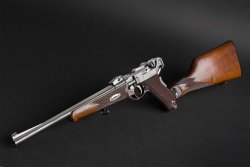
With lot 2425, we return to weapons that are better known to collectors and enthusiasts, although extremely rare: in this case we are dealing with a Luger 1902 carbine in 7.65 Parabellum caliber with serial number 23821. The walnut forend and shoulder stock have the same serial numbers and are in perfect condition, fitted with the original articulated swivels for the carrying strap. The barrel is 30 cm long and supports a micrometrically adjustable rear sight and a laterally adjustable front sight mounted on a finely checkered ramp. The magazine is nickel-plated sheet metal, with a wooden base. This interesting Luger carbine has apparently fired very few rounds and is in exceptionally good condition. The starting price has been set at €10,000.
Lot 2605 is an example of how up to the 1960s attempts were made to improve the working principle of revolvers, in this case by introducing some complications. The Dardick revolver was produced in the USA from 1954 to 1962 and is named after its designer David Dardick. The main characteristic of this hybrid between a pistol and a revolver is the feeding that was done with special cartridges, called "Tround", that were in fact normal .38 Special or .22 Long Rifle caliber ammo wrapped in a triangular plastic profile. The cartridges were contained in the grip and thanks to a rotating feeding system they were presented to the breech; after firing the spent cartridge case was ejected from the side window. Conceived as a survival weapon (the "Tround" cartridges floated even when loaded) and for law enforcement, the Dardick pistol could be equipped with a conversion that transformed it into a carbine with a 20 inch long barrel. It was a flop precisely because it used proprietary ammunition, incompatible with any other gun. This oddity is in good condition and is sold in its original box complete with conversion to carbine and instruction booklet at a starting price of €1,500.
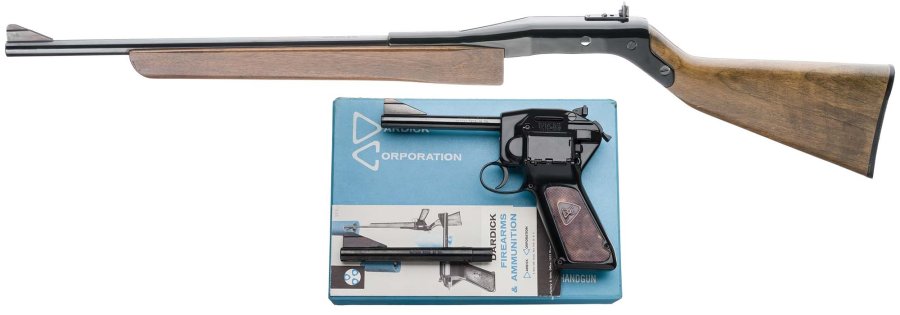
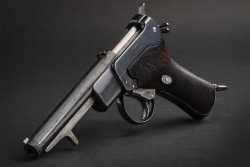
Lot 2719 is another absolute rarity, namely the Salvator Dormus pistol in 8mm caliber, considered the first semi-automatic handgun ever patented. It takes its name from Archduke Karl Salvator of Austria and Count George Dormus, who in 1891 filed the patent for this blowback semi-automatic pistol, in the hope that it would be adopted by the Austrian army. The delay of several years with which the competition was announced, however, gave time to competitors to perfect their projects, which proved to be superior.
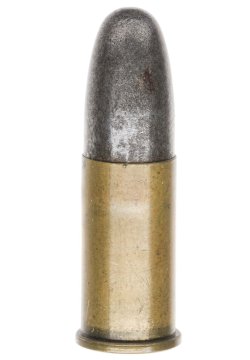
Manufacturing problems then prevented Salvator and Dormus to fulfill the experimental order of 100 pieces issued by the Austrian army, and it appears that only 31 pistols were completed.
The one at the Hermann Historica auction has the serial number 17. As is often the case, being first in a new area of technology does not always provide an advantage. The pistol is marked with the Austrian imperial eagle and the number 97 (very faint) and is in good condition, with some pitting on the metal parts and marks on the walnut grips. The barrel measures 145 millimeters and the sights were of the fixed type.
The pistol was fed using 5-round stripper clips. This pistol is also mentioned in the book by Mötz/Schuy, "Vom Ursprung der Selbstladepistole" (The Origin of Semi-Automatic Pistols), pages 191-219. The starting price is 15,000 euros. Lot 2720, offered at a starting price of 200 euros, is an equally rare 8mm caliber Dormus cartridge produced by G. Roth of Vienna. The case is made of brass, the bullet is fully iron jacketed.
The overall length of the cartridge is 30 mm. The 8mm Dormus cartridge is mentioned in the Mötz/Schuy book "Austrian Ammunition".
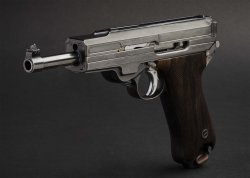
The last but not least important lot we want to show you is 2762, a rare prototype of a Müller System semi-automatic pistol in 7.65mm Luger with serial number 3. It is a short recoil operated gun designed by Bernhard Müller and manufactured in Winterthur, Switzerland, in 1902. The Swiss Army after adopting the Parabellum pistol in 1900 continued to test handguns and Müller's creature was one of the weapons considered. There is also evidence of contact between Bernhard Müller and the U.S. Army, but this did not lead to further developments. The Müller semi-auto is equipped with a 140 mm long barrel, uncovered as on other contemporary pistols, on which a drift adjustable sight is mounted.
The barrel rifling has four grooves. The rear sight is very simple and is little more than a U-shaped milling on the squared-off gun frame. The operating system is similar to that of the Walther P38 while the grip and eight-round magazine with wooden base and window for checking rounds is very akin to that of Luger pistols. The left side of the frame is marked "Syst. Müller 3." The original bluing has some spots and a few scratches. The grips are finely checkered walnut. The Müller pistol is mentioned in the Reinhart/Meier book, “Pistolen und Revolver der Schweiz seit 1720” (Swiss Pistols and Revolvers since 1720), pages 164 and 165. Due to ts extreme rarity, the starting price for this pistol is €12,000.
To learn more about Hermann Historica, please visit the Bavarian auction house's website where you can download the catalog or view all lots online.



